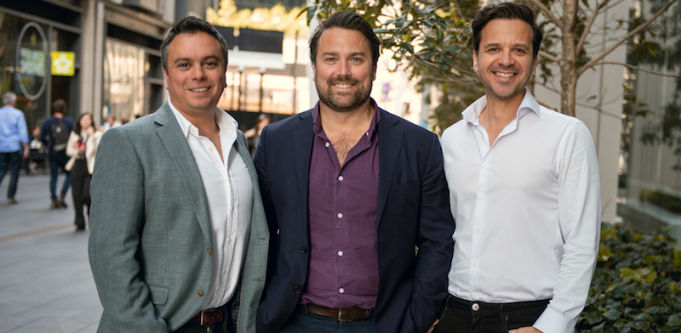
Slyp co-founders Mike Boyd, Paul Weingarth and Spiro Rokos. Source: Supplied.
Digital receipt startup Slyp has raised $2 million in seed funding, and it’s former Paypal and ANZ exec founders have a vision to change the way payments are managed, after the fact.
Founded in early-2017 by Paul Weingarth, Spiro Rokos and Mike Boyd, the startup allows ‘smart receipts’ to be automatically collected at the point of sale, and delivered to customers’ mobile phones and banking apps.
The investment comes from NAB Ventures and Reinventure, the venture capital arm of Westpac, and Slyp is also working directly with NAB to integrate the technology into the bank’s services.
Weingarth tells StartupSmart Slyp was born out of “passion around customer service” and, more specifically, frustration when a cashier asked him to take a picture of a paper receipt in order to store it digitally.
The startup ran a trial with NAB at the end of last year, and is gearing up to announce “major partners”, Weingarth says, but it’s not quite ready to go to market yet.
“There’s lots of lovely red tape to get through before we go into production,” he says.
However, once the co-founders started validating the technology, and the willingness of customers, merchants and banks to use it, “we realised there’s a lot more we can do with just receipts”, Weingarth says.
Now, Slyp is working on optimising value, allowing users to click through from digital receipts to a merchant’s store, or to re-book a restaurant from the receipt.
“Everybody typically has a mobile banking app on their phone,” he says.
“There’s a core utility there we can build on and create a new channel for merchants to interact with their customers,” he adds.
A global opportunity
The funding follows a $780,000 angel round completed last year, which Weingarth says covered building the Slyp prototype and expenses.
This latest round is pegged for getting the product ready to launch, and getting it to a bank-grade level.
“The majority will be [spent] on development and security,” Weingarth says, while some cash will go into business development.
The startup has also been hiring — it’s just brought on board four or five recruits, bringing the team of full-time staff to 12 people.
The plan is to “progress our product, so we can continue to innovate, scale and distribute over the foreseeable future”, Weingarth adds.
According to Weingarth, the product could conceivably be successful on a global scale, but he’s not looking overseas just yet.
“Initially, we want to prove it in our own backyard,” he says.
The startup has seen interest from global players, and is keeping discussions open, however for the next 12 to 18 months, the focus is on Australia, Weingarth says.
“We could pick any country in the world to deploy or initiate this tech into,” he says, “we definitely see this as a global opportunity”.
The three Slyp founders combine Weingarth’s experience as head of merchant partnerships at Paypal Australia and Rokos’s experience running Paypal’s technology practice in Australia, with Boyd’s banking background at ANZ.
While Paypal helped two of the founders in “learning the DNA of payments”, Boyd is the one to help them “navigate through the context of banking”, Weingarth says.
All three founders had a “relatively long stint” in corporates, he adds, where “it’s not often you see the vision of an idea and the scale at which you can make an impact”.
“It’s an every-person everyday challenge that we can go after. Sometimes you get opportunities that are too good to refuse,” he says.
Bring the product to life
Before going into a capital raise, Weingarth advises startups to “build a prototype and get as much validation for that prototype as possible”.
For Slyp, being able to prove and validate the concept “was really what helped us bring the product to life”, he says.
“Being able to demonstrate that to investors is absolutely something you want to do early on.”
Equally, however, he advises creating that prototype as quickly and as cheaply as possible, as “you don’t want to spend your own money on something the market hasn’t validated”.
Slide decks and static presentations are sometimes not enough to get investors interested, Weingarth says.
Prototyping brings the product to life in pitches and can make it easier to relate to, but it also means startups can collect real user feedback.
“Get real-end customer feedback and use that data to drive outcomes,” he advises.
“Then, take that to the investors,” he adds.
NOW READ: Up and away: Tech guru and former AFL coach launch Australia’s first digital bank


COMMENTS
SmartCompany is committed to hosting lively discussions. Help us keep the conversation useful, interesting and welcoming. We aim to publish comments quickly in the interest of promoting robust conversation, but we’re a small team and we deploy filters to protect against legal risk. Occasionally your comment may be held up while it is being reviewed, but we’re working as fast as we can to keep the conversation rolling.
The SmartCompany comment section is members-only content. Please subscribe to leave a comment.
The SmartCompany comment section is members-only content. Please login to leave a comment.